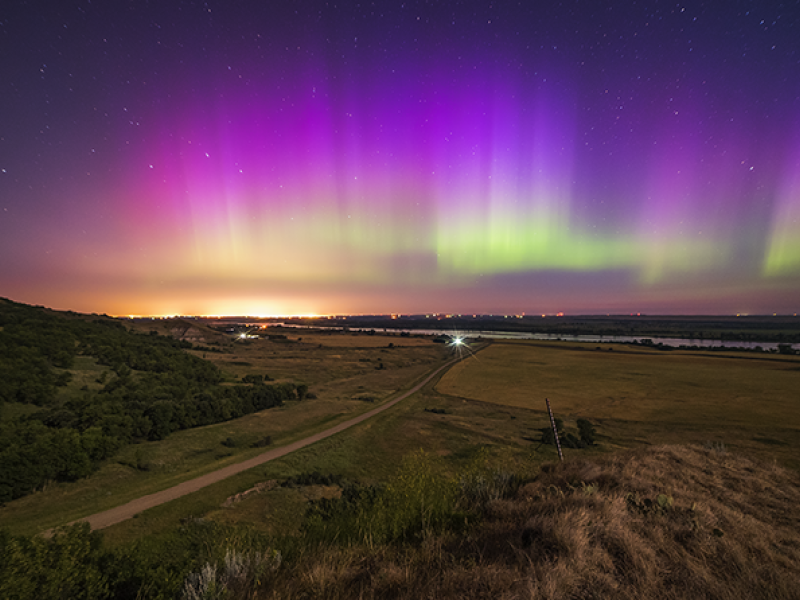North Dakota: Northern Lights and a Stargazer's Heaven
Northern Lights, galaxies, and stars. See them all right here!
Most of North Dakota is perfectly suited for viewing the many wonders of the night sky, including the spectacular aurora borealis (northern lights), stars, planets, and galaxies.
Northern Lights
North Dakota is one of the best places to scan the dark skies for the northern lights. Take a look outside on a crisp, clear night to see the amazing lights dance across a black background in vivid green, purple, blue, red and orange colors. Some of the best places for viewing the northern lights are Theodore Roosevelt National Park, any of North Dakota's state parks and scenic areas like Crow Flies High Butte at New Town and Mystical Horizons in the Turtle Mountains near Bottineau.

Aurora Forecasts are updated daily - watch for potential opportunities to view the Northern Lights. Please note that these are "projected" not guaranteed.


Knowing when and where to look for the stunning aurora borealis will help you make the most of the experience.
Here are some tips from North Dakota experts on the secrets of seeing the northern lights:
Step #1: Be Prepared
- The northern lights can appear year-round in North Dakota. Pay attention to local weather experts like NWS Bismarck, NWS Grand Forks, Space Weather Prediction Center or SpaceWeatherLive.com.
- Keep in mind that once an alert goes out, we won’t know for sure until about 30 minutes before showtime if the lights will happen or not, so stay on your toes!
- Keep an eye on other weather conditions. If your area is expected to get clouds, you most likely won’t see the lights. Sometimes even a full moon can drown them out.
Step #2: Be A Lights Chaser
- If the lights are going to happen in North Dakota, you don’t have to worry about going to a particular area of the state. They most likely will be seen statewide.
- Two to three hours after sunset tends to be the best viewing time. Make sure to go at least 20 to 30 miles outside of any town to avoid light pollution.
- Most importantly: BE PATIENT. The lights can happen for 10 to 15 minutes or they can stretch into the next night. They also will come in waves where they will get stronger and weaker over time.
Step #3: Be a Photographer
- If you’re trying to photograph the lights, it is essential to bring a tripod. The camera should be kept completely still.
- Make sure your camera allows you to manually keep your shutter open for longer periods of time (10-30 seconds) in order to let in the most light possible.
- Open your aperture as wide as it can go to help get even more light into your shot.

Looking for some out-of-this-world landscapes to capture the lights in? Click the photos below for some recommendations.
Stargazing
Stargazers don't have to drive far out of our larger cities and towns to be alone with the rest of the universe. Staring up, we wonder what's there. We contemplate things we can’t understand like how far is a thousand light years? Sometimes we're treated to meteor showers or the twinkling lights of jets flying over or a steady line of Starlink satellites; even the International Space Station cruising past.
Some of the better stargazing spots include:
1. Pembina Gorge - Enjoy a short hike on the Tetrault Trail and spoil yourself with gorgeous overlook where you can take in the Pembina River, the rolling hills and of course those sparkling stars above.
2. Rough Rider State Park - Imagine yourself staring up at a sky full of dazzling stars with the sounds of water calmly rolling at your feet. That right there is paradise.
3. Fort Abraham Lincoln State Park - The stars have been first-hand witnesses to North Dakota history. Experience it yourself by posting up at their campsite and strolling through the reconstructed earthlodge village.
4. Theodore Roosevelt National Park - A star show doesn’t get any better than here. Open 24 hours a day, you can sit and appreciate the quiet beauty of this national park with no interruptions.
5. Sheyenne National Grassland - With big horizons, comes big skies. The prairies of the Sheyenne National Grasslands are perfect to take in endless stars in the blink of an eye.
